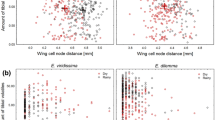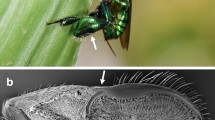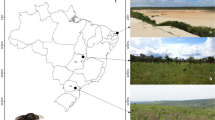Abstract
Male orchid bees collect volatile and semi-volatile compounds from the environment for storage and accumulation in specialized hind legs. Later, these compounds form a perfume blend used during courtship to lure conspecific females for mating. Male orchid bees perfume has been suggested to play an important role as a sexual signaling trait involved in pre-mating isolation of species, functioning as an indicator of male genetic quality. Eulaema nigrita Lepeletier (Apidae: Euglossini) is a common species in both forested and woody savanna (Cerrado stricto sensu) physiognomies of the Brazilian savanna biome. By identifying the chemical composition of male E. nigrita perfume, we tested for differences in the bouquet chemical profile in populations from remnants of seasonal semideciduous forest and woody savanna. In addition, we assessed the relation between perfume complexity and morphological traits associated with size and age of males. Our analysis showed a low effect of physiognomies on differences in the perfume chemical profile of sampled males. Nevertheless, we observed significant differences in the chemical profile of individuals from two seasonal semideciduous forest remnants, which suggests an environmental effect in individual bouquet. Wing wear measurements were positively related to perfume complexity, consistent with the premise that perfumes from older individuals are indicators of survival capacity in male orchid bees.




Similar content being viewed by others
Data Availability
The data underlying this article will be shared upon reasonable request to the corresponding author.
References
Ackerman JD, Mesler MR, Lu KL, Montalvo AM (1982) Food-foraging behavior of male Euglossini (Hymenoptera: Apidae): vagabonds or trapliners? Biotropica 14(241–248):2388080
Alcock J (1996) The relation between male body size, fighting, and mating success in Dawson’s burrowing bee, Amegilla dawsoni (Apidae, Apinae, Anthophorini). J of Zoology 239:663–674. https://doi.org/10.1111/j.1469-7998.1996.tb05469.x
Alves RJV, Pinto AC, Da Costa AVM, Rezende CM (2005) Zizyphus mauritiana Lam. (Rhamnaceae) and the chemical composition of its floral fecal odor. J Braz Chem Soc 16:654–656
Anderson MJ (2017) Permutational multivariate analysis of variance (PERMANOVA). In Wiley StatsRef: (eds Balakrishnan N, Colton T, Everitt B, Piegorsch W, Ruggeri F and Teugels JL). Statistics Reference Online. https://doi.org/10.1002/9781118445112.stat07841
Armbruster WS, Keller S, Matsuki M, Clausen TP (1989) Pollination of Dalechampia magnoliifolia (Euphorbiaceae) by male euglossine bees. Am J Bot 76:1279–1285. https://doi.org/10.1002/j.1537-2197.1989.tb15109.x
Boughman JW (2002) How sensory drive can promote speciation. Trends Ecol Evol 17(12):571–576. https://doi.org/10.1016/S0169-5347(02)02595-8
Brand P, Hinojosa-Díaz IA, Ayala R, Daigle M, Yurrita-Obiols CL, Eltz T, Ramírez SR (2020) The evolution of sexual signaling is linked to odorant receptor tuning in perfume-collecting orchid bees. Nat Commun 244:1–11. https://doi.org/10.1038/s41467-019-14162-6
Brandt K, Dötterl S, Ramírez SR, Etl F, Machado IC, Navarro DMdAF, Dobler D, Reiser O, Ayasse M, Milet-Pinheiro P (2021) Unraveling the olfactory biases of male euglossine bees: species-specific antennal responses and their evolutionary significance for perfume flowers. Front Ecol Evol 9:727471. https://doi.org/10.3389/fevo.2021.727471
Brandt K, Dötterl S, Fuchs R, Navarro DMDAF, Machado ICS, Dobler D, Reiser O, Ayasse M, Milet-Pinheiro P (2019) Subtle chemical variations with strong ecological significance: stereoselective responses of male orchid bees to stereoisomers of carvone epoxide. J Chem Ecol 45(5):464–473. https://doi.org/10.1007/s10886-019-01072-6
Burdock GA (2010) Fenaroli’s handbook of flavor ingredients, 6th edn. CRC Press, New York
Cardoso E, Moreno MIC, Bruna EM, Vasconcelos HL (2009) Mudanças fitofisionômicas no Cerrado: 18 anos de sucessão ecológica na Estação Ecológica do Panga. Caminhos Da Geografia 10:254–268. https://doi.org/10.14393/RCG103215980
Clarke KR, Warwick RM (2001) Change in marine communities: an approach to statistical analysis and interpretation, 2nd ed. PRIMER-E Ltd, Plymouth
Coyne JA, Orr HA (2004) Speciation. Sinauer Associates, Sunderland
Dressler RL (1982) Biology of the orchid bees. Annu Rev Plant Ecol Evol Syst 13:373–394. https://doi.org/10.1146/annurev.es.13.110182.002105
El-Sayed AM (2020) Thepherobase: database of pheromones and semiochemicals. In: The Pherobase. https://www.pherobase.com/database/compound/compounds-detail-(-)-trans-carvone%20epoxide.php. Accessed 4 March 2021
Eltz T (1997) Zur Duftstoffbiologie neotropischer Prachtbienen (Apidae: Euglossini), Diploma thesis, University Würzburg, Germany
Eltz T, Whitten WM, Roubik DW, Linsenmair KE (1999) Fragrance collection, storage, and accumulation by individual male orchid bees. J Chem Ecol 25(1):157–176. https://doi.org/10.1023/A:1020897302355
Eltz T, Roubik DW, Lunau K (2005) Experience-dependent choices ensure species-specific fragrance accumulation in male orchid bees. Behav Ecol Sociobiol 59:149–156. https://doi.org/10.1007/s00265-005-0021-z
Eltz T, Ayasse M, Lunau K (2006) Species-specific antennal responses to tibial fragrances by male orchid bees. J Chem Ecol 32:71–79. https://doi.org/10.1007/s10886-006-9352-0
Eltz T, Josten S, Mende T (2019) Stored perfume dynamics and consequences for signal development in male orchid bees. J Comp Physiol A 205:311–320. https://doi.org/10.1007/s00359-019-01319-3
Eltz T, Zimmermann Y, Haftmann J, Twele R, Francke W, Quezada-Euan JJG, Lunau K (2007) Enfleurage, lipid recycling, and the origin of perfume collection in orchid bees. Proc R Soc B 274:2843–2848. https://doi.org/10.1098/rspb.2007.0727
Eltz T, Zimmermann Y, Pfeiffer C, Ramirez-Pech J, Twele R, Francke W, Quezada-Euan JJG, Lunau K (2008) An olfactory shift is associated with male perfume differentiation and species divergence in orchid bees. Curr Biol 18:1844–1848. https://doi.org/10.1016/j.cub.2008.10.049
Eltz T, Bause C, Hund K, Quezada-Euan JJG, Pokorny T (2015) Correlates of perfume load in male orchid bees. Chemoecology 25:193–199. https://doi.org/10.1007/s00049-015-0190-9
Frantine-Silva W, Augusto SC, Tosta THA, Pacheco AS, Kotelok-Diniz T, Silva CA, Sofia SH (2021) Genetic diversity and population structure of orchid bees from the Brazilian savanna. J of Apic Res 60(3):385–395. https://doi.org/10.1080/00218839.2021.1898788
Furley PA (1999) The nature and diversity of neotropical savanna vegetation with particular reference to the Brazilian cerrados. Global Ecol Biogeogr 8(3–4):223–241. https://doi.org/10.1046/j.1466-822X.1999.00142.x
Gonçalves RVS, Cardoso JCF, Oliveira PE, Oliveira DC (2021) Changes in the Cerrado vegetation structure: insights from more than three decades of ecological succession. Web Ecol 21:55–64. https://doi.org/10.5194/we-21-55-2021
Henske J, Saleh NW, Chouvenc T, Ramírez SR, Eltz T (2023) Function of environment-derived male perfumes in orchid bees. Curr Biol 33:1–6. https://doi.org/10.1016/j.cub.2023.03.060
Jackson DE (2008) Sympatric speciation: perfume preferences of orchid bee lineages. Curr Biol 18(23):1092–1093. https://doi.org/10.1016/j.cub.2008.10.023
Janzen DH (1971) Euglossine bees as long-distance pollinators of tropical plants. Sci 171:203–205. https://www.jstor.org/stable/1731426
Kaiser R, Tollsten L (1995) An introduction to the scent of Cacti. Flav Fragr J 10:153–164
Kite GC, Hetterscheid WLA, Lewis MJ, Boyce PC, Ollerton J, Cocklin E, Diaz A, Simmonds MSJ (1998) Inflorescence odours and pollinators of Arum and Amorphophallus (Araceae). In Owens SJ, Rudall PJ (eds) Reproductive biology in systematics, conservation and economic botany, Royal Botanic Gardens, Kew, pp 295–315
Kroodsma DE (1975) Flight distances of male euglossine bees in orchid pollination. Biotropica 7:71–72
Legendre P, Legendre L (1998) Numerical ecology, 2nd edn. Elsevier, Amsterdam
Lopes SF, Schiavini I, Prado-Júnior JA, Gusson AE, Souza-Neto AR (2011) Caracterização ecológica e distribuição diamétrica da vegetação arbórea em um remanescente de floresta estacional semidecidual, na fazenda experimental do Glória, Uberlândia. MG Biosci J 27(2):322–335
Lopes SF, Schiavini I, Oliveira AP, Vale VS (2012) An ecological comparison of floristic composition in seasonal semideciduous forest in southeast Brazil: implications for conservation. Int J of For Res 1–14. https://doi.org/10.1155/2012/537269
Martel C, Gerlach G, Ayasse M, Milet-Pinheiro P (2019) Pollination ecology of the Neotropical gesneriad Gloxinia perennis: chemical composition and temporal fluctuation of floral perfume. Plant Biol 21:723–731. https://doi.org/10.1111/plb.12974
Milet-Pinheiro P, Gerlach G (2017) Biology of the Neotropical orchid genus Catasetum: a historical review on floral scent chemistry and pollinators. Perspect Plant Ecol Evol Syst 27:23–34. https://doi.org/10.1016/j.ppees.2017.05.004
Mitko L, Weber MG, Ramirez SR, Hedenström E, Wcislo WT, Eltz T (2016) Olfactory specialization for perfume collection in male orchid bees. J Exp Biol 219:1467–1475. https://doi.org/10.1242/jeb.136754
Mueller UG, Wolf-Mueller B (1993) A method for estimating the age of bees: age dependent wing wear and coloration in the wool carder bee Anthidium manicatum (Hymenoptera: Megachilidae). J Insect Behav 6(4):529–537
National Institute of Standards and Technology – NIST (2017) Mass Spectral Library with Search Program v20, Standard Version 2.4
Oksanen J (2020) Vegan: ecological diversity, available in: http://cran.auckland.ac.nz/web/packages/vegan/vignettes/diversity-vegan.pdf
Oliveira PE, Tomé CER, Torezan-Silingardi HM, Dötterl S, Silberbauer-Gottsberge I, Gottsberger G (2017) Differential pollination modes between distant populations of Unonopsis guatterioides (Annonaceae) in Minas Gerais and Amazonas, Brazil. Flora 232:39–46. https://doi.org/10.1016/j.flora.2016.07.014
Pinheiro J, Bates D, DebRoy S, Sarkar D, R Core Team (2021) nlme: linear and nonlinear mixed effects models. R package ver 3 1–152. Available in: https://cran.r-project.org/web/packages/nlme/index.html
Pokorny T, Hannibal M, Quezada-Euan JJG, Hedenström E, Sjöberg N, Bang J, Eltz T (2013) Acquisition of species-specific perfume blends: influence of habitat-dependent compound availability on odour choices of male orchid bees (Euglossa spp.). Oecologia 172:417–425. https://doi.org/10.1007/s00442-013-2620-0
Prado-Júnior JA, Maravalhas JB, Tosta THA, Rosa TF, Augusto SC, Vasconcelos HL (2020) Spatio-temporal changes in the structure of the ant, bee, and tree communities in the Brazilian cerrado. Oecol Aust 24:448–460. https://doi.org/10.4257/oeco.2020.2402.15
R Core Team (2020) R: a language and environment for statistical computing. R Foundation for Statistical Computing, Vienna, Austria. Available in: https://www.r-project.org/
Rebêlo JMM, Garófalo CA (1991) Diversidade e sazonalidade de machos de Euglossini (Hymenoptera, Apidae) e preferências por iscas odores em um fragmento de floresta no Sudeste do Brasil. Rev Bras Biol 51:787–799
Roberts DW (2019) labdsv: ordination and multivariate analysis for ecology. Available in: https://CRAN.R-project.org/package=labdsv
Sarkar D (2018) Lattice: multivariate data visualization with R. Springer, New York
Schwerdtfeger M, Gerlach G, Kaiser R (2002) Anthecology in the neotropical genus Anthurium (Araceae): a preliminary report. Selbyana 23(2):258–267. http://www.jstor.org/stable/41760124
Silveira GC, Freitas RF, Tosta THA, Rabelo LS, Gaglianone MC, Augusto SC (2015) The orchid bee fauna in the brazilian savanna: do forest formations contribute to higher species diversity? Apidologie 46:197–208. https://doi.org/10.1007/s13592-014-0314-1
Simpson G, Bates DM, Oksanen J (2019) permute: functions for generating restricted permutations of data. Available in: https://CRAN.R-project.org/package=permute
Smadja C, Butlin RK (2009) On the scent of speciation: the chemosensory system and its role in premating isolation. Hered 102:77–97. https://doi.org/10.1038/hdy.2008.55
Stern DL (1991) Male territoriality and alternative male-behaviors in the Euglossine bee, Eulaema meriana (Hymenoptera, Apidae). J Kans Entomol Soc 64(4):421–437. https://www.jstor.org/stable/25085309
Stone GN, Loder PMJ, Blackburn TM (1995) Foraging and courtship behavior in males of the solitary bee Anthophora plumipes (Hymenoptera, Anthophoridae): thermal physiology and the roles of body-size. Ecol Entomol 20(2):169–183. https://doi.org/10.1111/J.1365-2311.1995.TB00443.X
Teichert H, Dötterl S, Zimma B, Ayasse M, Gottsberger G (2009) Perfume-collecting male euglossine bees as pollinators of a basal angiosperm: the case of Unonopsis stipitata (Annonaceae). Plant Biol 11:29–37. https://doi.org/10.1111/j.1438-8677.2008.00101.x
Tosta THA, Silveira GC, Schiavini I, Sofia SH, Augusto SC (2017) Using short-term surveys and mark–recapture to estimate diversity and population size of orchid bees in forest formations of the Brazilian savanna. J Nat Hist 51(7–8):391–403. https://doi.org/10.1080/00222933.2016.1274441
Villalobos EM, Shelly TE (1991) Correlates of male mating success in two species of Anthidium bees (Hymenoptera: Megachilidae). Behav Ecol Sociobiol 29:47–53. https://doi.org/10.1007/BF00164294
Weber MG, Mitko L, Eltz T, Ramírez SR (2016) Macroevolution of perfume signalling in orchid bees. Ecol Lett 19:1314–1323. https://doi.org/10.1111/ele.12667
Whitten WM, Williams NH, Armbruster WS, Battiste MA, Strekowski L, Lindquist N (1986) Carvone oxide: an example of convergent evolution in euglossine pollinated plants. Syst Bot 11(1):222–228 (2418960)
Whitten WM, Young AM, Williams NH (1989) Function of glandular secretions in fragrance collection by male euglossine bees (Apidae: Euglossini). J Chem Ecol 15:1285–1295. https://doi.org/10.1007/BF01014830
Whitten WM, Young AM, Stern DL (1993) Nonfloral sources of chemicals that attract male euglossine bees (Apidae: Euglossini). J Chem Ecol 19:3017–3027. https://doi.org/10.1007/BF00980599
Wood S (2021) mgcv: mixed GAM computation vehicle with automatic smoothness estimation. Available in: https://CRAN.R-project.org/package=mgcv
Zappi D, Taylor NP (2020) Cactaceae in Flora e Funga do Brasil. Jardim Botânico do Rio de Janeiro. https://floradobrasil.jbrj.gov.br/FB1493. Accessed Sept. 28, 2022
Zimmermann Y, Roubik DW, Eltz T (2006) Species-specific attraction to pheromonal analogues in orchid bees. Behav Ecol Sociobiol 60:833–843. https://doi.org/10.1007/s00265-006-0227-8
Zimmermann Y, Ramírez SR, Eltz T (2009) Chemical niche differentiation among sympatric species of orchid bees. Ecol 90:2994–3008. https://doi.org/10.1890/08-1858.1
Acknowledgements
We are grateful to Ana Luisa Melo, Léo Correia, Thayane Araújo, and Jean Souza for their support with data collection, and Mário Machado Martins for his assistance and training with the GC-MS equipment. The authors also acknowledge the workers/owners of all sampling localities for permission to collect in their reserve areas. Finally, we thank the anonymous reviewers for their valuable comments on previous versions of this manuscript.
Funding
This work was supported by Coordenação de Aperfeiçoamento de Pessoal de Nível Superior—CAPES (Process 88887.337654/2019–00 to author KPC), Conselho Nacional de Desenvolvimento Científico e Tecnológico—CNPq (PELD-441142/2020–6), and Fundação de Amparo à Pesquisa do Estado de Minas Gerais and Fundação de Amparo à Pesquisa do Estado de Minas Gerais’—FAPEMIG (APQ 04815–17).
Author information
Authors and Affiliations
Contributions
The original project was designed by K. P. C. and S. C. A. Data collection was also performed by K. P. C. and S. C. A. A. T. T. and C. N. J. provided valuable assistances on the chemical analyses. K. P. C. was responsible for data analysis. The first draft of the manuscript was written by K. P. C. and all authors commented on previous versions of the manuscript. All authors read and approved the final manuscript.
Corresponding author
Ethics declarations
Competing Interests
The authors declare no competing interests.
Additional information
Edited by Stefano Colazza
Publisher's Note
Springer Nature remains neutral with regard to jurisdictional claims in published maps and institutional affiliations.
Supplementary Information
Below is the link to the electronic supplementary material.
Rights and permissions
Springer Nature or its licensor (e.g. a society or other partner) holds exclusive rights to this article under a publishing agreement with the author(s) or other rightsholder(s); author self-archiving of the accepted manuscript version of this article is solely governed by the terms of such publishing agreement and applicable law.
About this article
Cite this article
Palmera-Castrillon, K., Junqueira, C.N., Toci, A.T. et al. Complexity of the Male Perfume of Eulaema nigrita from Forest and Woody Physiognomies of the Brazilian Savanna: Is There a Relationship with Body Size and Wing Wear?. Neotrop Entomol 53, 330–341 (2024). https://doi.org/10.1007/s13744-023-01117-2
Received:
Accepted:
Published:
Issue Date:
DOI: https://doi.org/10.1007/s13744-023-01117-2




